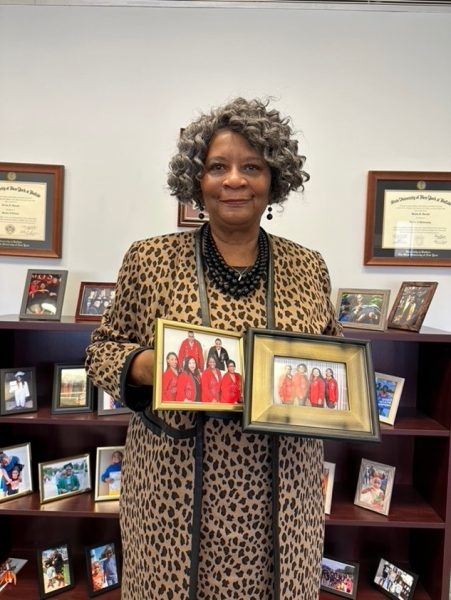Author shares reference for student writers
Paco Quebral stands with Nancy Sommers after her lecture.
Nancy Sommers, co-author of A Writers Reference, gave a speech about her academic essay, ‘I Stand Here Writing,’ and spoke about the required college handbook for College Writing Program courses on Friday at the Warren Enters Theatre in Upton Hall.
Sommers shared her passion for writing and the difficulty that comes with it. She introduced something to the campus that could be used not only throughout a college student’s career, but also throughout future endeavors after college. A Writers Reference was adopted by the campus last year, and it’s also the most widely used textbook in America, Sommers said.
Sommer, who has taught at Harvard University since 1987, wanted a way to unify her life and write an essay to “show that it’s possible to be both personal and academic.” This was an experiment not just for herself, but for her students, too.
Sommers went into depth about the difficulty of making connections between what’s known as your ‘personal life’ and ‘academic life.’ Through ‘I Stand Here Writing,’ she showed what making personal connections to your writing looks like. She is a firm believer of writing toward your interest and that writing in college is an exciting time for students.
“You have to believe when you choose what you’re writing about in college you can learn something about yourself,” Sommers said.
Dr. Michele Ninacs, assistant professor of English and director of the college writing program, has been touched by Sommers essay, ‘I Stand Here Writing,’ which is a common reading assignment for students.
“Every text you create in your life is a representation of who you are as a human being,” Ninacs said.
She wants her students to know that they don’t have to write by formula anymore and leave their ideas out of a paper, a similar message the article from Sommers is communicating to students.
At the beginning of each semester, students are often faced with the difficulties of buying textbooks. A lot of them are expensive and students have to make the decision to buy it while wondering if it’ll be used or not throughout the semester.
Ninacs shared the lengthy process of making these decisions. Ninacs, and members of the CWP, felt that Sommers’ book was the best fit for the institution. After an extensive year of reviewing dozens of books, Sommers’ handbook was the winner. Eventually, the committee made the choice of what they thought was the best fit for students.
“Once we narrowed it down to two, we actually did focus groups with students, we did focus groups with faculty, we had the publishers and the authors of the book come in and did extensive interviewing,” Ninacs said.
Financial benefits were kept in mind in the decision-making process. Ninacs shared that instead of students having to purchase three different books for three CWP courses, this would be the only book needed for all three classes.
“We wanted to make sure that students had one book that would serve them for all of these courses and when they go on to writing intensive courses, as well,” Ninacs said. “When I hear feedback from students, they love the book. This is a book that will go on your bookshelf next to your dictionary.”
Ninacs believes that having one book was also helpful for faculty. With faculty obtaining knowledge and becoming engaged on how to properly use the handbook, it became frequently used in the classroom. In turn, this helped students get the most use out of their money.
Sommers has given speeches at many universities and hosted several workshops that help professors respond to student writers or how to use the handbook. She is a Braddock Award Winner, nonfiction writer, blogger, and has made three educational films in addition to leading to Harvard’s Expository Writing Program for 20 years.
Email: [email protected]












